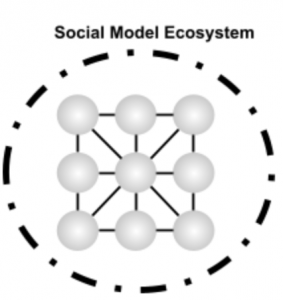Social Model Ecosystems
Please sign in or create your account in order to access this material.
Recovery is supported or hindered by the setting (the ecosystem) in which individuals live, learn, work, play and commune with one another. The social model of recovery can be understood through a human ecological lens. Ecologists study ecosystems, which are a community of living organisms interacting with each other and with their environment as a system. A social model ecosystem includes:

- People – The living organisms, represented as colored circles in the diagram, are people starting and sustaining recovery from substance use issues.
- Place – The dotted circle surrounding the people represents the setting or the environment in which participants network and interact within a social model group. The structure and integrity of the setting have both architectural and functional characteristics.
- Policies – The white space within the environment represents the rules, guidelines, social norms, and covenants that shape the interaction amongst the People and the Place.
- Interplay – The solid lines between the circles represent the interactions and relationships amongst individuals in the context of the environment.
Table of Contents
| Ecosystem Stability | |
| Social-Community Model |
Course Syllabus
Not Enrolled
| .1. Opposite of Addiction is Connection | ||
| .2. Social Determinants of Health | ||
| .2.1. SDOH vs. Medical Model | ||
| .2.2. Healthy People 2030: SDOH | ||
| .3. Social Model Ecosystems | ||
| .3.1. Ecosystem Stability | ||
| .3.2. Social-Community Model | ||
| .4. Sense of Community | ||
| .4.1. Perceived Sense of Community Scale | ||
| .4.2. Brief Sense of Community Scale | ||
| .5. Social Networks | ||
| .5.1. Abstinence-Specific Social Support | ||
| .5.2. Multiple Group Membership | ||
| .5.3. Multiple Dimensional Networks | ||
| .5.4. Personal vs "Whole" Networks | ||
| .5.5. Beneficial Characteristics of Social Networks | ||
| .5.6. Health Benefits of Social Networks | ||
| .6. Social vs Clinical Model | ||
| .6.1. Environment | ||
| .6.2. Staff | ||
| .6.3. Authority | ||
| .6.4. Recovery Orientation | ||
| .6.5. Governance | ||
| .6.6. Community Orientation | ||
| .7. Quiz: Social Model |
